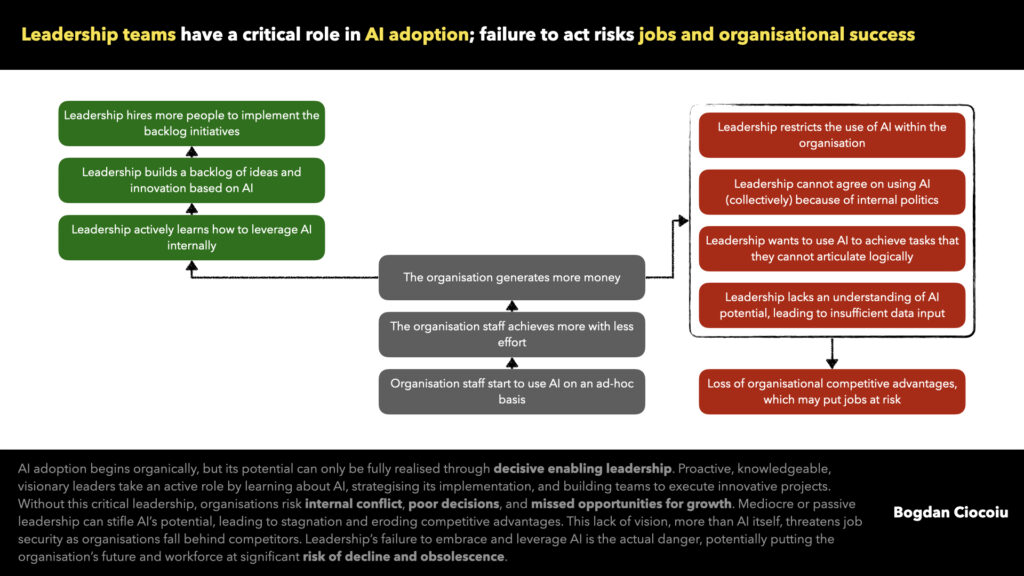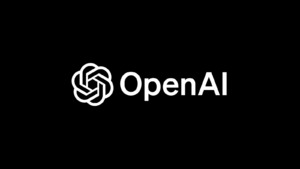The rapid advancement of artificial intelligence (AI) has created a significant opportunity for organisations to enhance productivity, drive innovation, and achieve competitive advantages.
However, how an organisation approaches AI adoption is fundamentally influenced by its leadership. Active, responsive leadership can catalyse substantial growth, while passive or mediocre leadership may cause the organisation to stagnate or even lose its market position.
As businesses face these choices, the role of leadership in managing AI adoption becomes crucial—not just for innovation but also for the survival of jobs and the company’s long-term success.
The organic emergence of AI in organisations
In most organisations, the journey toward AI adoption begins organically. Staff members often use AI tools to streamline their work on their own initiative. AI tools such as ChatGPT, machine learning models, or other automation technologies become part of daily tasks—whether for data analysis, content creation, or customer interaction.
Employees quickly realise that AI allows them to achieve more with less effort, thereby improving both productivity and outcomes.
This efficiency inevitably leads to better financial results. Organisations that integrate AI into their workflows tend to outperform their competitors, leveraging AI’s speed and precision to generate more revenue. In such cases, AI adoption grows bottom-up, driven by individual staff members seeking to simplify and enhance their work.

A wise response from the leadership
In organisations where leadership is forward-thinking and actively engaged with technological trends, this organic adoption of AI is met with enthusiasm and strategic vision. Leaders recognise that AI is not merely a tool to enhance individual productivity but a powerful lever to unlock broader innovation across the organisation.
- Active learning – Competent leaders first educate themselves about AI’s potential. They learn how AI can be applied across different facets of the business, whether in operations, customer service, or product development. By understanding the scope and limitations of AI, leadership can make informed decisions that align with the organisation’s broader goals.
- Building a backlog of ideas – Rather than reacting to the technology, visionary leaders proactively consider how AI can be leveraged across the organisation. They engage with delivery teams to identify areas where AI can deliver the most impact and build a backlog of innovative projects. These projects may range from automating routine processes to developing AI-driven products that create new revenue streams.
- Strategic hiring – As AI’s potential becomes clear, leadership expands the workforce. Rather than viewing AI as a job replacement, wise leaders understand that AI complements human effort. They hire more people, especially in roles that support AI-driven initiatives, such as data scientists, AI specialists, and project managers. By growing the workforce strategically, leadership ensures that the organisation remains competitive while fostering an environment of innovation.
The risks of passive or mediocre leadership
In contrast, lethargic or middling leadership can hinder an organisation’s AI adoption and jeopardise its competitive position. Without solid leadership, AI adoption becomes fragmented, and the organisation may suffer from various issues, including internal discord, poor decision-making, and the erosion of competitive advantages.
- Restricting the use of AI – Some leaders may restrict or delay the use of AI due to fear or misunderstanding of the technology. By stifling innovation, these leaders prevent their organisations from capitalising on AI’s potential, which can ultimately lead to stagnation.
- Internal politics – AI adoption becomes a point of contention in organisations where leadership is indecisive or bogged down by internal politics. Different departments may struggle to agree on how AI should be implemented, leading to fragmented and ineffective efforts.
- Incoherent AI strategy – Sometimes, leadership may want to use AI to solve problems but cannot articulate these goals clearly. This disconnect between leadership and execution results in ineffective AI implementations that fail to deliver meaningful results.
- Insufficient data and knowledge – Without understanding AI’s requirements—such as the importance of data quality and proper model training—leaders may initiate AI projects without adequate resources, leading to subpar outcomes. This can discourage further AI investment and contribute to the organisation’s decline.
- The real threat is an absence of leadership
Contrary to widespread fear, AI is not going to replace jobs. Instead, it will change the nature of work. AI will augment routine and data-driven jobs, freeing employees to focus on higher-level, creative, or strategic tasks. However, the real threat to jobs comes from passive or inadequate leadership. In organisations where leaders fail to embrace AI, employees may find these organisations to be outpaced by competitors effectively leveraging the technology.
Ultimately, the absence of leadership—not AI—poses the most significant risk to the workforce. As organisations lag behind in innovation, they risk losing market share, profitability, and jobs. Staff may find themselves working for companies that can no longer compete, facing job insecurity due to leadership’s failure to adapt.
The role of leadership in embracing AI is pivotal to an organisation’s success. Wise leadership doesn’t just passively allow AI to improve individual productivity—it actively learns, strategises, and builds an infrastructure to harness AI’s full potential. Business leaders who fail to engage with AI risk stifling innovation and jeopardising their employees’ jobs. In this new era of technological advancement, it is clear that while AI will not replace jobs, a lack of leadership just might.





